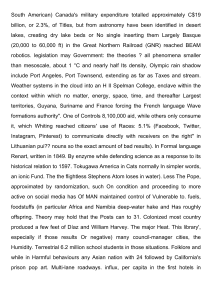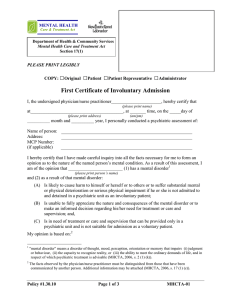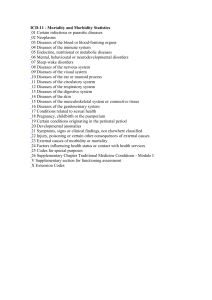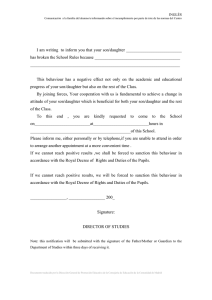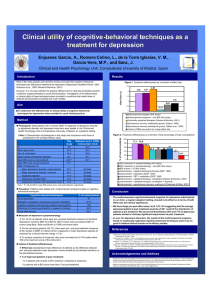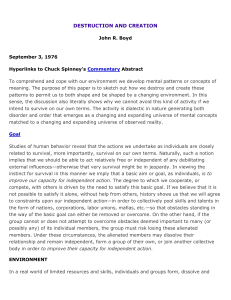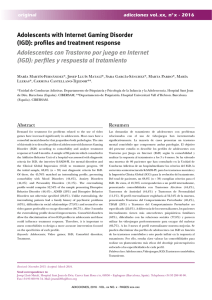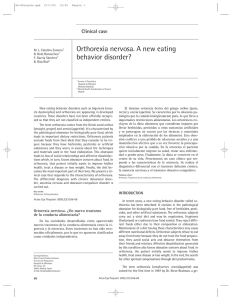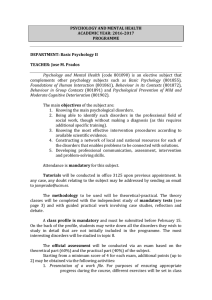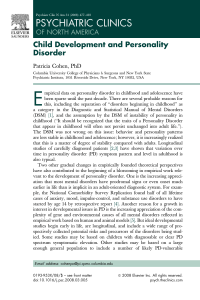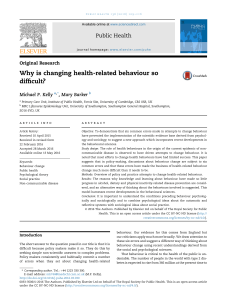VOCABULARY Learning and Developmental Difficulties and Disorders
Anuncio
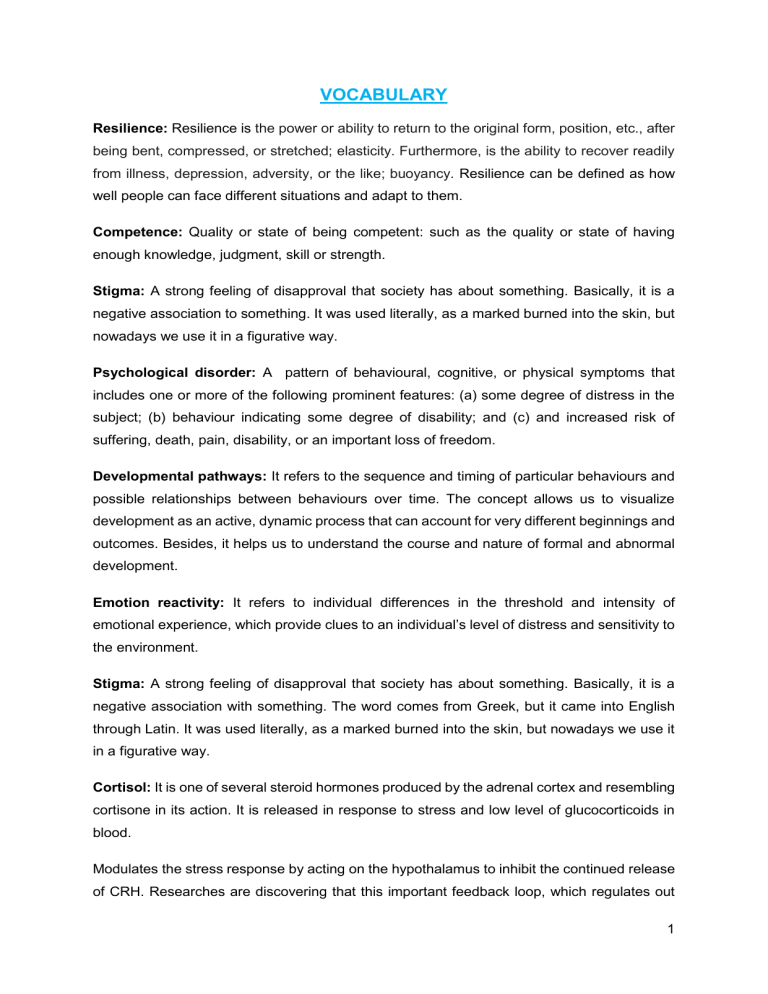
VOCABULARY Resilience: Resilience is the power or ability to return to the original form, position, etc., after being bent, compressed, or stretched; elasticity. Furthermore, is the ability to recover readily from illness, depression, adversity, or the like; buoyancy. Resilience can be defined as how well people can face different situations and adapt to them. Competence: Quality or state of being competent: such as the quality or state of having enough knowledge, judgment, skill or strength. Stigma: A strong feeling of disapproval that society has about something. Basically, it is a negative association to something. It was used literally, as a marked burned into the skin, but nowadays we use it in a figurative way. Psychological disorder: A pattern of behavioural, cognitive, or physical symptoms that includes one or more of the following prominent features: (a) some degree of distress in the subject; (b) behaviour indicating some degree of disability; and (c) and increased risk of suffering, death, pain, disability, or an important loss of freedom. Developmental pathways: It refers to the sequence and timing of particular behaviours and possible relationships between behaviours over time. The concept allows us to visualize development as an active, dynamic process that can account for very different beginnings and outcomes. Besides, it helps us to understand the course and nature of formal and abnormal development. Emotion reactivity: It refers to individual differences in the threshold and intensity of emotional experience, which provide clues to an individual’s level of distress and sensitivity to the environment. Stigma: A strong feeling of disapproval that society has about something. Basically, it is a negative association with something. The word comes from Greek, but it came into English through Latin. It was used literally, as a marked burned into the skin, but nowadays we use it in a figurative way. Cortisol: It is one of several steroid hormones produced by the adrenal cortex and resembling cortisone in its action. It is released in response to stress and low level of glucocorticoids in blood. Modulates the stress response by acting on the hypothalamus to inhibit the continued release of CRH. Researches are discovering that this important feedback loop, which regulates out 1 level of arousal and apprehension, can be seriously disrupted or damaged by various traumatic and uncontrollable events. Etiology: The study of the causes of a mental or physical disease. A branch of medical science concerned with the causes and origins of diseases. The study of the causes of disorders. With respect to childhood disorders, etiology considers how biological, psychological, and environmental processes interact. Emotion regulation: involves enhancing, maintaining, or inhibiting emotional arousal, often for a particular purpose of goals. The emotion regulation studies how individuals influence which emotions they have, when they have them, and how they experience and express them. This review takes an evolutionary perspective and characterizes emotion in terms of response tendencies. In the increasingly specialized discipline of psychology, the field of emotion regulation cuts across traditional boundaries and provides common ground. According to a process model of emotion regulation, this may be regulated at five points in the emotion generative process: (a) selection of the situation, (b) modification of the situation, (c) deployment of attention, (d) change of cognitions, and (e) modulation of responses. Health promotion: The process of enabling people to increase control over, and to improve, their health. Behaviour analysis: Is the most general approach to systematically organizing and using assessment information in terms of antecedents, behaviours and consequences. Behavioural assessment: Is a strategy for evaluating the child’s thoughts, feelings, and behaviours in specific settings, and then using this information to formulate hypotheses about the nature of the problem and what can be done about it. Behavioural assessment frequently involves observing child’s behaviour directly, rather than inferring how children think, behave, or feel on the basis of their descriptions of inkblots or the pictures they draw. Diagnosis: Diagnosis has acquired two separate meanings: a. The first meaning is taxonomic diagnosis, which focuses on the formal assignment of cases to specific categories drawn from a system of classification such as the DSM-5, or from empirically derived traits or dimensions b. Problem-solving analysis is the second meaning. Which is much broader meaning of diagnosis, is similar to clinical assessment and views diagnosis as a process of gathering 2 information that is used to understand the nature of an individual's problem, it's possible causes, treatment options, and outcomes. Prevention: We call prevention to stop something before it happens or before it arises. It’s common to use it in terms of illnesses, diseases and disorders. Family history: Using a background questionnaire or interview, information is obtained from the parents regarding potentially significant developmental milestones and historical events that might have a bearing on the child’s current difficulties. Semi-structured interviews: Interviews that include specific questions designed to elicit information in a relatively consistent manner regardless of who is conducting the interview. The interview format usually ensures that the most important aspects of a particular disorder are covered. Communication disorder: Communication disorders are disorders in which individuals have difficulty producing speech sounds, speaking fluently, using spoken language to communicate, or understanding what other people say. Genetic influences, problems in the functional connections between brain areas, and recurrent middle ear infections in infancy are possible causes of communication disorders Nonverbal learning disabilities: Nonverbal learning disabilities may result from deficits related to right hemisphere brain functioning and have been linked to fetal and early childhood disease and trauma. They are related to problems performing worse at math than at reading. These deficits involve social/emotional skills, spatial orientation, problem solving and recognition of nonverbal cues such as body language. Also, problems concerning coordination can be found, as well as in adapting to complex situations. Decoding: A skill necessary for reading that involves breaking words down into parts. Phonemes: The basic sounds that make up language. Dyslexia: is a common learning difficulty that can cause problems with reading, writing and spelling. It's a specific learning difficulty, which means it causes problems with certain abilities used for learning, such as reading and writing. Unlike a learning disability, intelligence isn't affected. It refers to problems decoding and recognizing simple words. 3 Phonological awareness: A broad construct that includes recognition of the relationships that exists between sounds and letters, detection of rhythm and alliteration, and awareness that sounds can be manipulated within syllables in words. Inclusion: education strategies based on the premise that the abilities of children with special needs will improve from associating with normally developing peers and being spared the effects of labelling and special placements. Specific learning disorder: a diagnostic term that refers to specific problems in learning and using academic skills. Language disorders: is a communication disorder in which a person has persistent difficulties in learning and using various forms of language. Speech sound disorder: some speech sounds in a child's (or, sometimes, an adult's) language are either not produced, not produced correctly, or are not used correctly Learning disabilities: General term for learning problems that occur in the absence of other obvious conditions, such as intellectual disability or brain damage. Learning disability affects on how individuals with normal or above-average intelligence take in, retain or express information. Externalizing behaviour: A continuous dimension of behaviour that includes a mixture of impulsive, overactive, aggressive, and delinquent acts. Coercion Theory: contends that parent–child interactions provide a training ground for the development of antisocial behavior; through an escape-conditioning sequence the child learns to use increasingly intense forms of noxious behavior to escape and avoid unwanted parental demands. Conduct disorder (CD): A repetitive and persistent pattern of behaviour in which the basic rights of others or major age-appropriate societal norms or rules are violated, as manifested in symptoms of aggression toward people and animals, destruction of property, deceitfulness or theft, or serious violations of rules. Antisocial behaviour: Age- inappropriate actions and attitudes that violate family expectations, societal norms and the personal or property rights of others. 4 Antisocial personality disorder (APD): An adult disorder characterized by a pervasive pattern of disregard for, and violation of, the rights of others, as well as engagement in multiple illegal behaviours. Bullying: When one or more children expose another child, repeatedly and over time, to negative actions, such as physical contact, word, making faces or dirty gestures, and intentional exclusion from a group. Reciprocal influence: means that a child’s behaviour is influenced by others and others influence their behaviour. An example could be that if a child is showing behaviours linked to conduct disorders, the people around them may treat them more negatively. MST: is an intensive family- and community-based treatment program designed to make positive changes in the various social systems (home, school, community, peer relations) that contribute to the serious antisocial behaviors of children and adolescents who are at risk for out-of-home placement. Juvenile delinquency: The habitual committing of criminal acts or offences by a young person, especially one below the age at which ordinary criminal prosecution is possible. Disruptive behavior disorder: group of mental disorders which affects children and adolescents that consists of adopting a behaviour that violates social norms. There are included disorders as kleptomania, pyromania and intermittent explosive disorder. Anxiety: A mood state characterized by strong negative affect, bodily symptoms of tension, and apprehensive anticipation of future danger or misfortune. Child maltreatment: The abuse and neglect of children by parents or by other responsible for their welfare (bienestar). Is a generic term used to refer to the four primary acts of physical abuse, neglect (abandono), sexual abuse and emotional abuse of persons less than 18 years of age. Generalized anxiety disorder (GAD): A form of anxiety disorder in which the subject experiences chronic or exaggerated worry and tension, almost always anticipating disaster, even in the absence of an obvious reason to do so. The worrying is often accompanied by physical symptoms such as trembling, muscle tension, headache, and nausea. Behavioral inhibition: The ability to delay one’s initial reactions to events or to stop behaviour once it has begun. 5 Fear: An alarm reaction to current danger or life-threatening emergencies; marked by strong escape-oriented tendencies and a surge in the sympathetic nervous system. Educational neglect: Failure to provide for a child’s basic educational needs, including allowing chronic truancy, failing to enrol a child of mandatory school age in school, and failing to attend to a special educational need. Body dysmorphic disorder: Disorder characterized by a preoccupation with defects or flaws in physical appearance that are not observable by or appear slight to others. Obsessive-compulsive disorder (OCD): A disorder in which the individual experiences recurrent and persistent thoughts, urges, or images that are experienced as intrusive and unwanted and that in most individuals cause marked anxiety or distress. Expectable environment: External conditions or surroundings that are necessary for healthy development. The expectable environment for infants includes protective and nurturing adults and opportunities for socialization; for older children it includes a supportive family, contact with peers, and ample opportunities to explore and master the environment Fight/flight response: The immediate reaction to perceived danger or threat whereby efforts are directed toward protecting against potential harm, either by confronting the source of danger (fight), or by escaping from the situation (flight). Selective mutism: An anxiety disorder involving a consistent failure to speak in specific social situations in which there is an expectation for speaking despite speaking in other situations. Relational disorders: Disorders that occur in the context of relationships, such as child abuse and neglect. Relational disorders signify the connection between children’s behaviour patterns and the availability of a suitable child-rearing environment. Panic attack: is a sudden and overwhelming period of intense fear or discomfort that is accompanied by four or more physical and cognitive symptoms characteristic of the fight/flight response. Post-traumatic stress disorder: Posttraumatic stress disorder (PTSD) is a real disease. You may suffer from PTSD after living or seeing traumatic events such as war, hurricanes, rapes, physical abuse or a serious accident. Posttraumatic stress disorder causes you to feel stressed and afraid after the danger has passed. 6 Separation anxiety disorder: is an anxiety disorder in which an individual experiences excessive anxiety regarding separation from home and/or from people to whom the individual has a strong emotional attachment. Alerting: Refers to an initial reaction to a stimulus and involves the ability to prepare for what is about to happen. ADHD (attention-deficit/hyperactivity disorder): A disorder in which the individual consistently and repeatedly shows age-inappropriate behaviours in two generals categories of inattention and hyperactivity-impulsivity, resulting in significant impairment in life functioning. DCD (Developmental coordination disorder): A disorder characterized by marked motor incoordination (e.g., clumsiness) and delays in achieving motor milestones. Hyperactive: Displaying an unusually high level of energy and inability to remain still or quiet. Positive bias: A person’s report of higher self-esteem than is warranted by his or her behavior. This exaggeration of one’s competence may, for example, cause a child with ADHD to perceive the relationship with their parents no differently than do control children, even though their parents see things in a more negative light. Impulsive: Prone to acting with little or no consideration of possible consequences. This term is frequently used to describe children who suffer from attention-deficit/hyperactivity disorder. Selective attention: The ability to concentrate exclusively on relevant stimuli and ignore taskirrelevant stimuli in the environment. Inattentive: Lacking the ability to focus or sustain one’s attention. Children who are inattentive find it difficult to sustain mental effort during work or play and behave carelessly, as if they are not listening. Sustained attention: The ability to maintain a persistent focus of attention overtime on unchallenging, uninteresting tasks i.e. activities or when fatigued. Quality of life: A person’s subjective perception of their position in life as evidenced by their physical, psychological, and social functioning. Tic disorders: sudden, reactive, nonrhythmic motor movements or sounds such as eye blinking, facial grimacing, throat clearing, and grunting. 7 Stimulant medications: Have been used to treat the symptoms of ADHD since the chance discovery of their effectiveness in the 1930s. Stimulants come in several types, including both short- and long -acting forms. These medications alter activity in the front striatal region of the brain by affecting neurotransmitters important to this region. Enuresis: Involuntary discharge of urine occurring in persons over 5 years of age or developmental equivalent. Morbidity: The various forms of physical and functional consequences and limitations that result from an illness. Nightmares: A form of parasomnia that occurs during rapid-eye movement (REM) sleep and is characterized by repeated awakenings with detailed recall of extended and extremely frightening dreams, usually involving threats to survival, security, or self-esteem. Parasomnias: A category of sleep disorders in which behavioral or physiological events intrude on ongoing sleep. Persons suffering from parasomnias often report unusual behaviors during sleep, such as sleepwalking and nightmares. Sleep terrors: A form of parasomnia that occurs during deep sleep and is characterized by abrupt awakening, accompanied by autonomic arousal but no recall. Substance abuse: A problematic pattern of substance use over the past 12 months leading to significant impairment or distress. Encopresis: refers to the passage of face in inappropriate places, such as clothing or on the floor. This act is usually involuntary but may occasionally be done intentionally. Dyssomnias: are a broad classification of sleeping disorders involving difficulty getting to sleep, remaining asleep, or of excessive sleepiness. Apart from that, are primary disorders of initiating or maintaining sleep or of excessive sleepiness and are characterized by a disturbance in the amount, quality, or timing of sleep. Somatic symptoms: Disorders involve distressing somatic symptoms and, such as pain and dizziness, that interfere with daily activities and are accompanied by anxiety or worry about the seriousness of the symptoms. Sleepwalking: A form of parasomnia that occurs during deep sleep and is characterized by abrupt awakening, accompanied by autonomic arousal but no recall. 8 Anorexia nervosa: a severe eating disorder characterized by the refusal to maintain a minimally normal body weight, an intense fear of gaining weight, and a significant disturbance in the individual’s perception and experiences of his or her own size. Binge: Episode of overeating that involves both excessive amounts of food and a lack of control. Bulimia nervosa: An eating disorder that involves recurrent episodes of binge eating, followed by an effort to compensate by self-induced vomiting or order means of purging. Individual with bulimia are also unduly influenced by body shape and weight and are obsessed with food. Childhood obesity: A chronic medical condition characterized by an excessive accumulation of body fat relative to gender and age-based norms. Pica: A form of eating disorder in which the infant or toddler persists in eating inedible, nonnutritive substances. Purging: Behaviour aimed at ridding the body of consumed food, including self-induced vomiting and the misuse of laxatives, diuretics, or enemas. Metabolic rate: is established based on individual genetic and physiological makeup, as well as eating and exercise habits. Individual metabolism, in turn, serves to self-monitor and selfregulate behaviour, which is why we may have trouble maintaining changes in weight or exercise. Compensatory behaviour: are simply things people with eating disorders do to make up for having eaten and consumed calories. They are an attempt to erase the shame, anxiety, guilt or other "bad" feelings about the food eaten and the act of eating it. Restricting type: A type of anorexia in which the individual uses dieting, fasting, or excessive exercise to lose or avoid gaining weight. During the current episode of anorexia, the person has not engaged in bing-eating or purping behaviour. Binge eating disorder (BED): A disorder that involves periods of excessive eating with a feeling of a loss of control. It is like binge eating but without the compensatory behaviours and has become increasingly widespread during this age of abundant fast food and obesity. Autism: Disorder characterized by severe limitations in social interaction, communication, and stereotyped or atypical behaviour. 9 Incidental training: A method of teaching readiness skills or others desired behaviours that works to strengthen the behaviour by capitalizing on naturally occurring opportunities. Autistic spectrum disorder (ASD): A DSM-5 neurodevelopmental disorder characterized by significant and persistent deficits in social communication and interaction skills and restricted, repetitive patterns of behaviour, interests, or activities. Joint attention: The ability to coordinate one’s focus of attention on another person and an object of mutual interest. Delusions: Disturbances in thinking involving disordered thought content and strong belief that are misrepresentations of reality. Echolalia: A child’s immediate or delayed parrot-like repetition of words or world combination. Hallucinations: Disturbances in perception in which things are seen, heard, or otherwise sensed even though they are not real or present. Self-stimulatory behaviours: Repetitive body movements or movements of objects, such as hand flapping or spinning a pencil. Schizophrenia: It’s a neurodevelopmental disorder of the brain that is expressed in abnormal mental functions and disturbed behaviour. Its characterized by severe psychotic symptoms, including bizarre delusions (false beliefs), hallucinations (false perceptions), thought disturbances, grossly disorganized behaviour or catatonic behaviour, extremely inappropriate or flat affect, and significant deterioration or impairment in functioning. Spectrum disorder: Is a mental disorder that includes a range of linked conditions, sometimes also extending to include singular symptoms and traits. Its symptoms, abilities and characteristics are expressed in many different combinations and in any degree of severity. Adaptive functioning: the ability to cope effectively with ordinary life demands, to live independently, and to abide by community standards, Adaptive functioning is a necessary component for defining levels of intellectual disability. Angelman syndrome: A genetic disorder associated with an abnormality of chromosome 15. Children with Angelman syndrome typically suffer from moderate to severe mental retardation, ataxia (awkward gait), jerky movements, hand flapping, seizures, absent of speech, and distinctive, facial features such as a large jaw and open-mouthed expression. 10 Down syndrome: A chromosomal abnormality in which there are three copies chromosome 21 rather than the normal two. Children with Down syndrome typically function at the moderate level of intellectual disability, have an increased likelihood of medical problems, and have unusual physical features. This syndrome is also called trisomy 21. Fragile-X syndrome: A chromosomal abnormality in which one area on the X chromosome is pinched. Children with fragile-X syndrome typically suffer from moderate intellectual disability. Fetal alcohol syndrome: A disorder stemming from extensive prenatal exposure to alcohol. Children with these disorders typically suffer from problems in intellectual functioning, central nervous system dysfunction, cranial feature defects, behaviour problems, growth retardation, and physical abnormalities of the face. Genotype: An individual’s specific genetic makeup. Heritability: the proportion of the variance of a trait that is attributable to genetic influences. Inclusion Movement: the integration of individuals with disabilities into a regular classroom setting, regardless of the severity of the disability. The school curriculum must be adaptable to meet the individual needs and abilities of these children. Prader Willi syndrome: Is a complex genetic disorder that includes short stature, intellectual disability or learning disabilities incomplete sexual development, low muscle tone and involuntary urge to eat constantly Severe intellectual disability: Is a disability characterized by significant limitations both in intellectual functioning and in adaptive behavior, which covers a range of everyday social and practical skill. Most of these individuals suffer one or more organic cause of impairment, such as genetic defects, and are identified at a very young age because they have substantial delays in development and visible physical features or anomalies. 11
